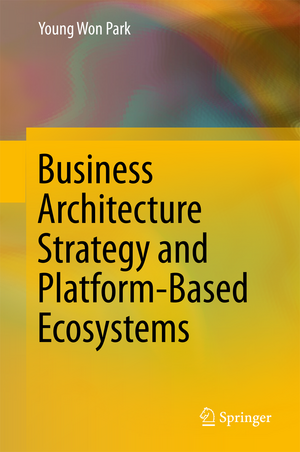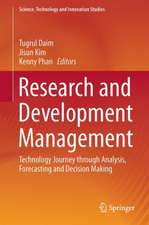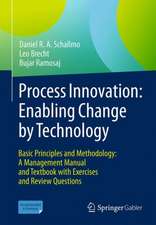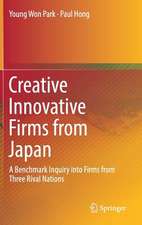Business Architecture Strategy and Platform-Based Ecosystems
Autor Young Won Parken Limba Engleză Hardback – 10 noi 2017
Secondly, the book discusses platform-based ecosystems. Crucial issues for today’s firms are associated with value creation through their platform and ecosystem framework. With a major emphasis on modular product architecture, US firms have focused heavily on platform development in modular industries. Their base is operation system (OS) software, so that IT firms in general focus on software capabilities—and digital control in particular. In contrast, the advantage for Japanese firms is not digital but analog control. Without any drastic changes in their industry practices, Japanese firms are likely to sustain their analog platform advantage.
The book subsequently puts forward a holistic view through the connection of business architecture strategy and platform-based ecosystems. The theoretical framework and case illustrations are especially useful to firms involved in a variety of industries that must respond to the turbulent environmental changes of the digital era. Most of the cases target not only Japanese firms but also many other global firms. Readers are systematically shown how to balance technological competence and customer competence by using the framework of business architecture strategy and platform-based ecosystems.
| Toate formatele și edițiile | Preț | Express |
|---|---|---|
| Paperback (1) | 882.96 lei 6-8 săpt. | |
| Springer Nature Singapore – 23 dec 2018 | 882.96 lei 6-8 săpt. | |
| Hardback (1) | 888.80 lei 6-8 săpt. | |
| Springer Nature Singapore – 10 noi 2017 | 888.80 lei 6-8 săpt. |
Preț: 888.80 lei
Preț vechi: 1083.90 lei
-18% Nou
Puncte Express: 1333
Preț estimativ în valută:
170.09€ • 184.70$ • 142.88£
170.09€ • 184.70$ • 142.88£
Carte tipărită la comandă
Livrare economică 22 aprilie-06 mai
Preluare comenzi: 021 569.72.76
Specificații
ISBN-13: 9789811055348
ISBN-10: 9811055343
Pagini: 150
Ilustrații: XI, 129 p. 30 illus., 28 illus. in color.
Dimensiuni: 155 x 235 mm
Greutate: 0.38 kg
Ediția:1st ed. 2018
Editura: Springer Nature Singapore
Colecția Springer
Locul publicării:Singapore, Singapore
ISBN-10: 9811055343
Pagini: 150
Ilustrații: XI, 129 p. 30 illus., 28 illus. in color.
Dimensiuni: 155 x 235 mm
Greutate: 0.38 kg
Ediția:1st ed. 2018
Editura: Springer Nature Singapore
Colecția Springer
Locul publicării:Singapore, Singapore
Cuprins
Introduction.- Product Architecture and IT strategy.- Global Business Model Building based on the Three Core Competences and Business architecture.- Architecture Analysis for Sustainable Innovations.- Architecture analysis and core competence strategy for Emerging Markets.- Integration of Mechanical, Electric, and Software Development utilizing Architecture Analysis.- Integration of Platform Strategy and Product Architecture.- Japanese Monozukuri and Platform-based Ecosystem Strategy.- Dynamic Influence Management System and Organizational Change.- Moving Forward: For Global Integrated Manufacturing Information System (GIMIS).
Notă biografică
Young Won Park, Saitama University
Textul de pe ultima copertă
This book provides a framework and real case analyses concerning business architecture strategy and platform-based ecosystems. Firstly, the book introduces a framework of business architecture strategy and suggests an engineering process that employs a business architecture analysis system in which the various business best-practices information technology (IT) tools are integrated into an interface. More specifically, this architecture analysis provides the means to realize two essential features: a strategy that allows global firms to sense changing market needs, and a tool that combines mechanical engineering with electronics and software IT tools.
Secondly, the book discusses platform-based ecosystems. Crucial issues for today’s firms are associated with value creation through their platform and ecosystem framework. With a major emphasis on modular product architecture, US firms have focused heavily on platform development in modular industries. Their base is operation system (OS) software, so that IT firms in general focus on software capabilities—and digital control in particular. In contrast, the advantage for Japanese firms is not digital but analog control. Without any drastic changes in their industry practices, Japanese firms are likely to sustain their analog platform advantage.
The book subsequently puts forward a holistic view through the connection of business architecture strategy and platform-based ecosystems. The theoretical framework and case illustrations are especially useful to firms involved in a variety of industries that must respond to the turbulent environmental changes of the digital era. Most of the cases target not only Japanese firms but also many other global firms. Readers are systematically shown how to balance technological competence and customer competence by using the framework of business architecture strategy and platform-based ecosystems.
Secondly, the book discusses platform-based ecosystems. Crucial issues for today’s firms are associated with value creation through their platform and ecosystem framework. With a major emphasis on modular product architecture, US firms have focused heavily on platform development in modular industries. Their base is operation system (OS) software, so that IT firms in general focus on software capabilities—and digital control in particular. In contrast, the advantage for Japanese firms is not digital but analog control. Without any drastic changes in their industry practices, Japanese firms are likely to sustain their analog platform advantage.
The book subsequently puts forward a holistic view through the connection of business architecture strategy and platform-based ecosystems. The theoretical framework and case illustrations are especially useful to firms involved in a variety of industries that must respond to the turbulent environmental changes of the digital era. Most of the cases target not only Japanese firms but also many other global firms. Readers are systematically shown how to balance technological competence and customer competence by using the framework of business architecture strategy and platform-based ecosystems.
Caracteristici
Provides a solid theory base grounded in existing literature on business product architecture and platform-based ecosystems Includes illustrations of practical IT methods as particularly interesting practical examples for managers and senior executives Highlights the most recent case analyses with practical managerial examples and details that will benefit both Japanese and other global firms Includes supplementary material: sn.pub/extras

























